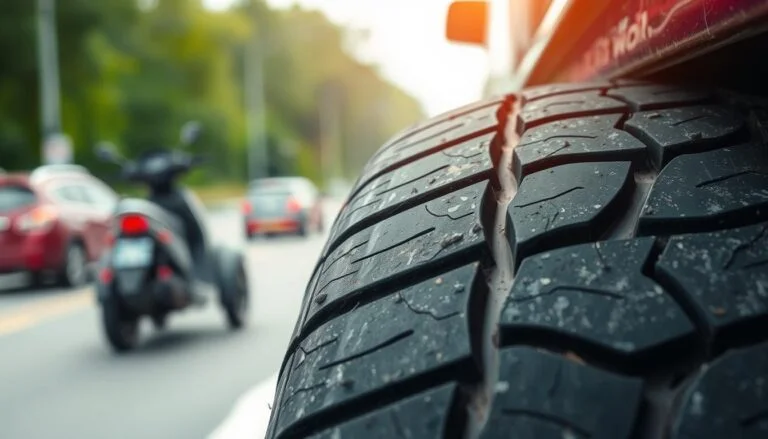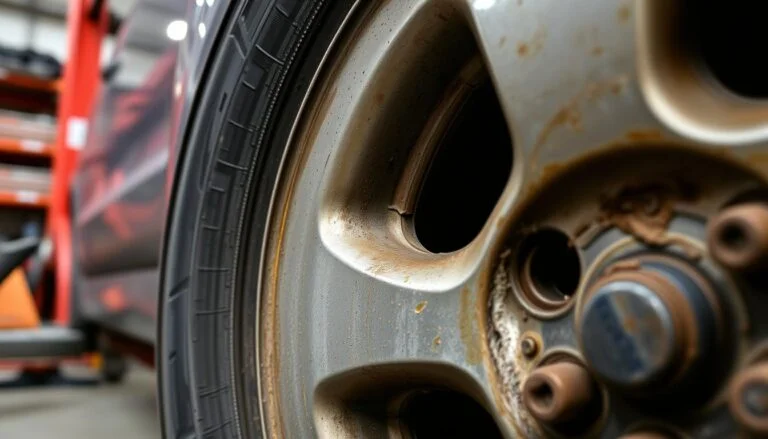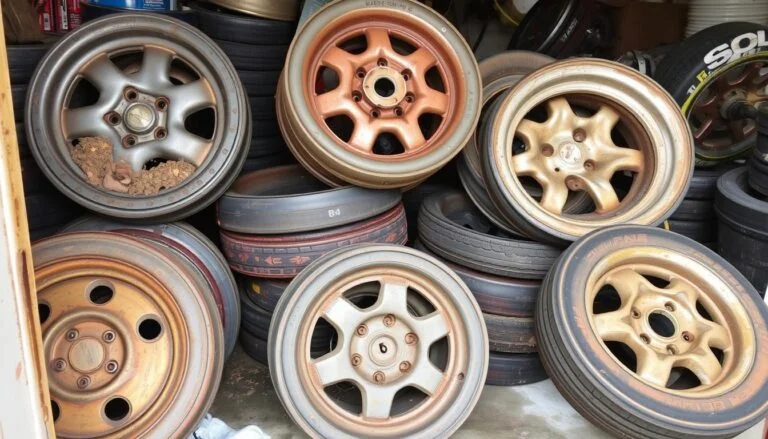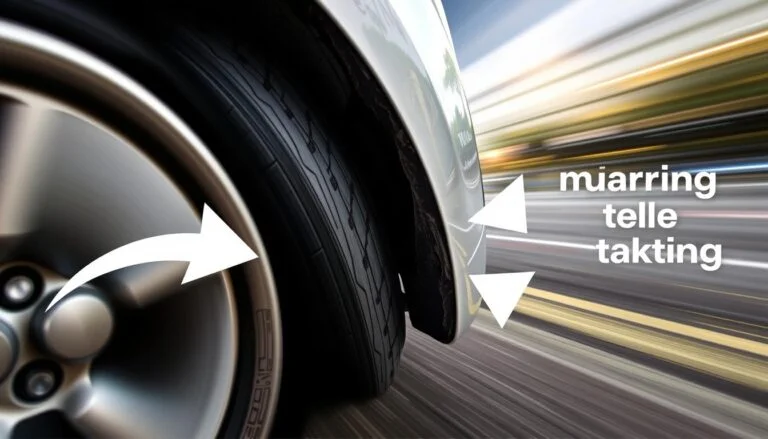How to Prevent Wheel-Related Accidents?
Keeping your car safe means knowing how to take care of your wheels. Wheel accidents can be very serious. They often happen because people don’t check their car’s maintenance or drive safely. By checking your tires and driving smart, you can lower the chance of these accidents.
There are many ways to keep your car and everyone in it safe. This includes checking your tires often and making sure they’re inflated right. We’ll look at how to avoid wheel accidents and share important safety tips.
Learning about car wheel safety is more than just keeping your tires in good shape. It’s about keeping everyone safe on the road.

Key Takeaways
- Regular tire maintenance is crucial for preventing wheel-related accidents.
- Proper tire inflation enhances vehicle safety and performance.
- Understanding the importance of wheel safety can save lives.
- Proactive driving techniques contribute to overall road safety.
- Adopting essential car wheel safety measures minimizes accident risks.
Importance of Wheel Safety
Keeping your vehicle’s wheels safe is crucial. Good wheel safety tips help prevent injuries. Neglecting wheels can cause serious problems like tire blowouts or losing control, which raises accident risks.
Understanding Wheel-Related Dangers
Many dangers come from wheels, like under-inflated tires, worn-out tread, and bad wheel alignment. These problems can lead to accidents. Following expert wheel safety tips can greatly reduce these dangers and prevent injuries.
Statistics on Wheel-Related Accidents
The National Highway Traffic Safety Administration (NHTSA) shows how important it is to take care of your wheels. They say tire-related crashes are a big reason for accidents. The AAA Foundation for Traffic Safety found that keeping tires properly inflated and checked often can lower accident rates a lot.
| Source | Key Statistic |
|---|---|
| NHTSA | 15% of vehicle accidents are tire-related |
| AAA Foundation for Traffic Safety | Proper tire maintenance reduces accidents by 20% |
Regular Tire Maintenance Best Practices
Keeping your tires safe and long-lasting is key. It’s all about checking tread depth and keeping the right air pressure. This guide will show you how to do these important steps right.
Inspecting Tire Tread Depth
Checking your tire’s tread depth is a must for safety. It helps your car grip the road better, especially on wet or icy surfaces. Use a special gauge to measure it. The Rubber Manufacturers Association says you should replace tires if the depth is less than 2/32 of an inch.
Having enough tread depth is crucial for your car to run well.
Checking for Tire Damage
It’s important to look for tire damage often. This can stop sudden blowouts and accidents. Look for cuts, punctures, and cracks on the sidewalls. Also, check for any objects stuck in the tire.
Fixing these problems quickly is a big part of keeping your tires in good shape.
Proper Tire Inflation
Keeping your tires at the right air pressure is key for saving fuel and making tires last longer. If they’re not right, they can wear out unevenly or even blow out. The Rubber Manufacturers Association says to check tire pressure monthly with a good gauge.
Look in your car’s manual for the correct pressure. Following these steps is a big part of taking care of your tires.
| Maintenance Task | Frequency | Tools Needed |
|---|---|---|
| Inspect Tread Depth | Monthly | Tread Depth Gauge |
| Check for Damage | Monthly/After long trips | Visual Inspection |
| Check Tire Pressure | Monthly | Pressure Gauge |
How to Prevent Wheel-Related Accidents
Keeping tires in good shape and ensuring wheels work well are key to safe driving. Regular checks and maintenance, like rotating tires and balancing wheels, help a lot. These steps can greatly lower the chance of accidents.
Frequent Tire Rotation
Rotating tires often is a must to avoid blowouts and make tires last longer. By doing this every 6,000 to 8,000 miles, you make sure the tread wears evenly. Uneven wear can cause wheels to lose grip, which is dangerous.
Big tire brands like Michelin say to follow certain patterns, like the rearward cross or X-pattern. This keeps tires running smoothly and your car stable.
Wheel Balancing Techniques
Balancing wheels right is also very important. Unbalanced wheels can shake your car, wear tires down unevenly, and stress the suspension. Bridgestone says to balance wheels every time you change or rotate tires.
Technicians use special tools to find and fix any weight issues. This makes driving smooth and safe, helping to prevent blowouts and keep you safe on the road.
“Consistent tire maintenance, including rotation and balancing, is crucial for maximizing tire longevity and ensuring a safe driving experience.” – Michelin
- Regularly rotate tires every 6,000 to 8,000 miles.
- Follow recommended rotation patterns like rearward cross or X-pattern.
- Balance wheels with each tire rotation or replacement.
- Use professional services for precise wheel balancing.
Road Safety Precautions
Staying safe on the road means knowing about different road conditions. The American Automobile Association (AAA) and the Federal Highway Administration (FHWA) offer key advice. By using good road safety precautions and techniques, drivers can lower their accident risk.
Understanding Road Conditions
It’s important to know and adjust to different road conditions. Wet roads can make tires lose grip, leading to skidding. Construction zones have sudden lane changes, so drivers must be extra careful. The FHWA suggests keeping up with traffic updates to avoid hazards.
Also, icy or snowy roads require slower speeds and more space between cars.
Adapting Driving Style in Different Environments
Changing your driving style for the road environment is key. On highways, keep a steady speed and stay in your lane. In cities, be ready for stops and watch out for pedestrians.
Driving at night means using high beams and slowing down. Following these tips makes driving safer for everyone.
Vehicle Collision Prevention Tips
Keeping the roads safe is crucial, and the best way to do this is by being proactive. The Insurance Institute for Highway Safety (IIHS) offers insights on how to lower the risk of car crashes. By taking certain steps, you can make the roads safer.
First, make sure to follow your car’s maintenance schedule. This includes checking your tires regularly. Bad tires can cause your car to lose control. Here are some key steps:
- Regular Tire Inspections: Check the tread depth and look for any damage.
- Proper Tire Inflation: Keep the tires at the right pressure for better control.
- Frequent Tire Rotation: Rotate tires to wear them evenly and keep your car stable.
- Wheel Balancing: Balanced wheels prevent uneven wear and reduce vibrations.
By following these tips, you can control your car better and avoid accidents. Also, learning to drive in different weather conditions is important. It helps you handle unexpected situations on the road.
“By maintaining your vehicle and staying aware of your surroundings, you significantly reduce your risk on the road.” – Insurance Institute for Highway Safety (IIHS)
Let’s look at some important statistics on how these tips can help:
| Maintenance Aspect | Impact on Collision Risk |
|---|---|
| Regular Tire Inspections | Reduces collision risk by 10% |
| Proper Tire Inflation | Improves vehicle handling by 15% |
| Tire Rotation | Ensures balanced wear, lowering collision chances by 8% |
| Wheel Balancing | Decreases vibrational impacts, reducing risks by 5% |
By using these road accident prevention strategies, drivers can greatly improve their safety. This leads to fewer car crashes on the road.
Identifying and Avoiding Tire Blowouts
Tire blowouts can be scary and dangerous. Knowing the warning signs early can prevent them. Learning these signs helps keep you safe on the road.
Recognizing Warning Signs
Every driver should know the signs of a blowout. Look out for:
- Visible Tire Damage: Cuts, cracks, or bulges on the tire surface
- Excessive Vibration: Unusual shaking or vibrations while driving
- Uneven Tread Wear: Inconsistent wear patterns on tire tread
- Low Tire Pressure: Regularly checking and maintaining tire pressure
Check your tires for these signs often. Ignoring them can lead to a blowout.
Steps to Take During a Blowout
If a tire blows out, knowing how to react is key. Follow these steps for a safe response:
- Maintain a firm grip on the steering wheel
- Avoid abruptly braking; instead, gradually decelerate
- Keep the vehicle moving straight to avoid losing control
- Once slowed down, safely pull over to the side of the road
- Activate hazard lights to alert other drivers
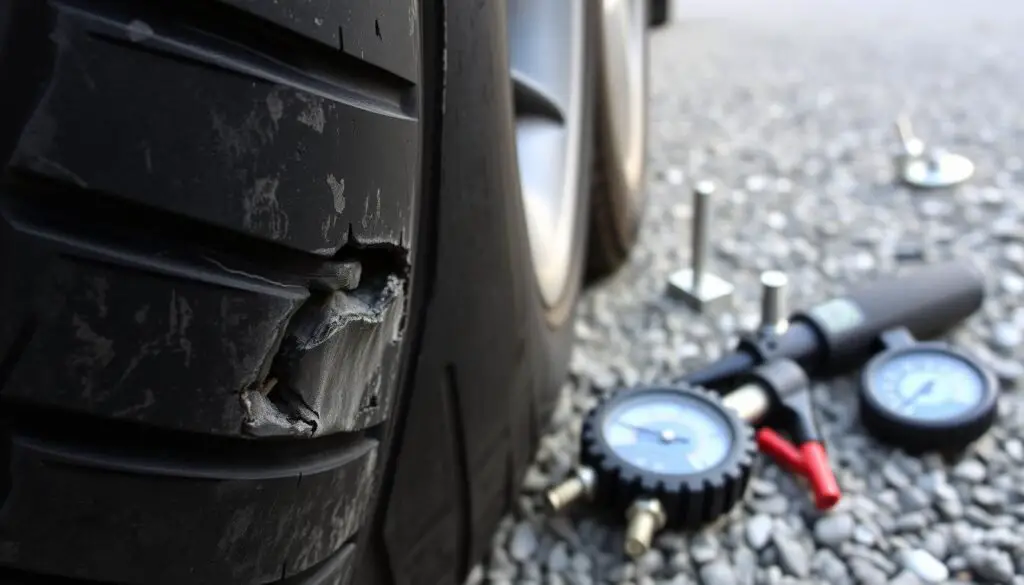
Safe Driving Techniques to Protect Wheels
Protecting your vehicle’s wheels is key. Safe driving techniques not only make driving better but also save you money on repairs. Let’s look at important strategies that focus on safety and efficiency.
Maintaining Safe Speeds
Keeping a safe speed is crucial for wheel protection. Driving at the right speed helps your tires stay in good contact with the road. This reduces stress on your wheels. The National Safety Council suggests following speed limits and adjusting your speed based on road conditions to avoid accidents.
Avoiding Sudden Turns and Stops
Sudden turns or stops can harm your wheels. By avoiding these, your tires wear more evenly. This makes your wheels last longer. Plan your moves ahead, brake gently, and steer smoothly.
Driving in Poor Weather Conditions
Driving in bad weather needs extra care. Wet, icy, or foggy conditions can make roads slippery and hard to see. Use safe driving tips like slowing down, leaving more space, and avoiding quick moves. Also, check your tire’s tread and pressure to ensure they work well.
Preventing Wheel Alignment Issues
Keeping your wheels aligned is key for safety and performance. Misalignment can cause uneven tire wear, which affects handling and may lead to accidents. Spotting and fixing these problems early can prevent expensive repairs and dangerous situations.
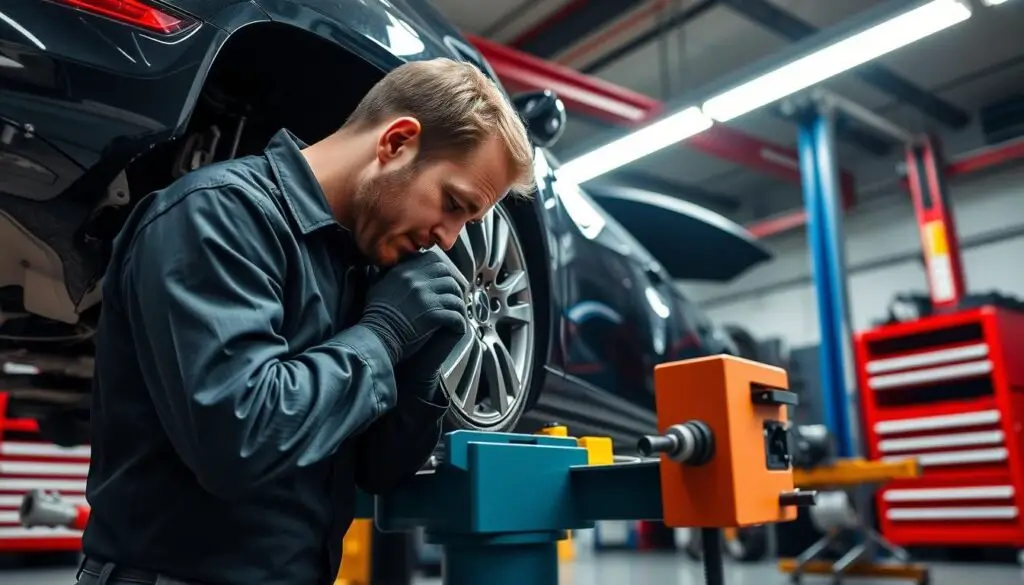
To handle wheel alignment problems well, knowing their causes is crucial. The Society of Automotive Engineers (SAE) suggests regular checks and adjustments based on your driving habits. Here are some ways to preventing wheel alignment issues:
- Perform Regular Inspections: Check your wheel alignment every 6,000 miles or as advised by your vehicle manufacturer. This helps in detecting misalignment early.
- Look for Signs of Misalignment: Uneven tire wear, the vehicle pulling to one side, and vibrating steering wheels are common indicators of alignment issues.
- Avoid Potholes and Curbs: Hitting potholes or curbs can significantly disturb your wheel alignment. Drive cautiously, especially on rough roads.
- Schedule Professional Alignment Services: Periodically, have a professional mechanic align your wheels. DIY fixes may not address the issue comprehensively.
Following these tips can keep your vehicle running smoothly and safely. By tackling preventing wheel alignment issues early, you ensure a safer and more enjoyable drive.
| Signs of Misalignment | Consequences | Preventive Measures |
|---|---|---|
| Uneven Tire Wear | Reduced Tire Life | Regular Tire Rotation |
| Vehicle Pulling to One Side | Unsafe Handling | Timely Wheel Alignment |
| Vibrating Steering Wheel | Driver Fatigue | Professional Inspections |
Road Hazard Awareness and Mitigation
Knowing about road hazards is key to keeping your wheels safe and driving safely. This part talks about common road dangers and how to handle rough roads. This helps lower the chance of wheel damage and accidents.
Identifying Common Road Hazards
Being aware of road hazards is important for wheel safety. The Department of Transportation (DOT) lists some common ones:
- Potholes
- Debris
- Uneven road surfaces
- Standing water
Knowing these hazards helps you avoid damage to your vehicle’s wheels.
Tips for Navigating Rough Roads
Here are some key tips for driving safely on rough roads:
- Reduce Speed: Slowing down lets you react faster to avoid hazards.
- Stay Alert: Watch the road closely, especially in dark or bad weather.
- Keep a Safe Distance: Keep a safe gap from the car in front to react to sudden changes.
- Learn and React: Know your usual roads well and plan detours if needed.
Using these tips for road hazards and navigating rough roads keeps your wheels and driving safe.
Conclusion
This guide has covered many ways to lower car accident rates. We talked about the key role of wheel safety and maintenance. Regular tire checks, correct inflation, and safe driving are all important.
Tire rotation and balancing are essential for a safe vehicle. Knowing about road dangers and adjusting your driving helps prevent accidents. These steps are vital for keeping everyone safe on the road.
Making wheel safety a priority can save lives. By following these safety tips, drivers can make the roads safer for all. It’s a step towards a safer driving world.
Additional Resources
We’ve gathered a list of valuable resources to help you learn more about wheel safety and driving precautions. These resources offer in-depth information and helpful links to keep you safe on the road.
The National Highway Traffic Safety Administration (NHTSA) website is a great place to start. It has detailed guides on tire maintenance and road safety. You can also find updates on new safety rules for drivers. Check out NHTSA.gov for all you need to know about safe driving.
The Federal Highway Administration (FHWA) is another excellent resource. On their website, FHWA.dot.gov, you’ll find lots of info on road safety and driving techniques. These links will help you stay safe on different roads and get the most out of your vehicle.
Many tire companies also offer safety tips and educational materials. Brands like Michelin, Goodyear, and Bridgestone have online tools and guides. These resources help you understand tire health and the need for regular checks. Use these resources to keep your wheels in the best shape.
FAQ
What are the best practices for regular tire maintenance?
Regular tire maintenance means checking the tread depth and looking for damage. It also includes making sure the tires are inflated correctly. The Rubber Manufacturers Association (RMA) gives guidelines for keeping tires at the right pressure. This helps prevent accidents and improves how your car performs.
How can I prevent wheel-related accidents?
To avoid wheel-related accidents, rotate your tires often and balance them properly. Following car wheel safety tips is also important. Michelin and Bridgestone experts say these steps help keep your wheels safe and your driving safe too.
Why is wheel safety important?
Wheel safety is key because ignoring it can cause tire blowouts and loss of control. The National Highway Traffic Safety Administration (NHTSA) and AAA Foundation for Traffic Safety show how common and dangerous these accidents are. Regular maintenance and being careful are crucial.
How can I recognize and avoid tire blowouts?
Spotting signs of a tire blowout, like vibrations or bulges, is important. The National Traffic Safety Board (NTSB) suggests what to do next. This includes keeping a firm grip on the wheel and slowing down slowly.
What road safety precautions should drivers take?
Drivers should know the road conditions and adjust their driving. The American Automobile Association (AAA) and Federal Highway Administration (FHWA) say to slow down and be careful on wet roads and in construction zones. This helps avoid accidents.
How can I prevent vehicle collisions with good wheel maintenance?
Preventing vehicle collisions starts with regular wheel maintenance and staying alert. The Insurance Institute for Highway Safety (IIHS) says being proactive and careful while driving is key. This helps keep your wheels safe and your driving safe too.
What are the safe driving techniques to protect wheels?
Safe driving techniques include driving at safe speeds and avoiding sudden turns and stops. Driving carefully in bad weather also helps. The National Safety Council (NSC) offers tips for safe driving in all weather conditions.
How can I prevent wheel alignment issues?
To avoid wheel alignment problems, watch for signs like uneven tire wear and steering issues. The Society of Automotive Engineers (SAE) has advice on fixing these problems quickly. This keeps your vehicle safe and running well.
What should I know about road hazard awareness and mitigation?
Knowing common road hazards like potholes and debris is important. The Department of Transportation (DOT) has tips for driving safely on rough roads. Following these can help avoid wheel damage and accidents.


